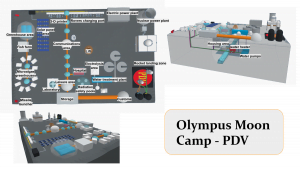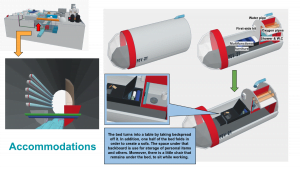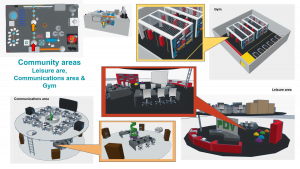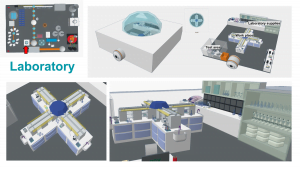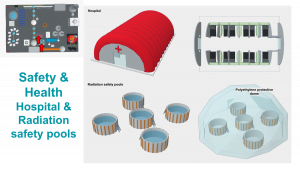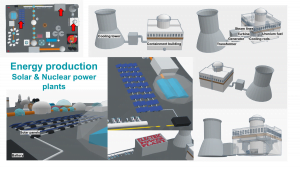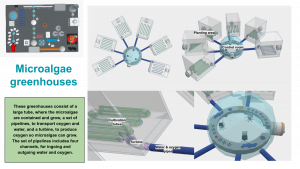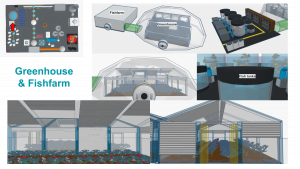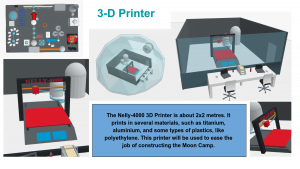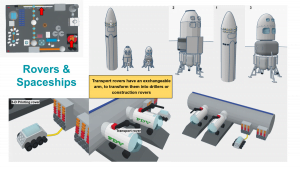Moon Camp Explorers Gallery 2020-2021
In Moon Camp Explorers each team’s mission is to 3D design a complete Moon Camp using Tinkercad. They also have to explain how they will use local resources, protect astronauts from the dangerous of space and describe the living and working facilities.
Team: PDV
IES Punta del Verde Sevilla Spain 14
External link for 3d
|
Project description
The Olympus Moon Camp was named after Mount Olympus. Olympus means the highest among the highest of all. In addition, Mount Olympus was the dwelling of the Olympian gods, as we all know. We named our Moon Camp after the name of this mount because we wanted its name to be as grandiose as an expedition to The Moon is. |
|||
|
Where do you want to build your Moon Camp?
Close to the Lunar Poles Why did you choose this location?
We chose this location because it has a lot of sunlight. Due to this, we will have access to a higher amount of solar energy. In addition, both poles of The Moon have deep lunar craters and lava tunnels, which we will use to build our homes and other structures. Not only that, we thought this location could open new investigation gates, since it has been said by expert that there is an ancient frost layer in the South Pole, which may be even older than our Planet Earth. We would like our Moon Camp to be an investigation source for the rest of humans, so that is why we thought we would take the chance to investigate other matters, as well. How do you plan to build your Moon Camp? Which materials would you use?
We decided to principally use aluminum, titanium, and polyethylene, because they are both lightweight and resistant; but we would use other materials, such as steel, too. We would carry most of the materials from Earth. Moreover, a 3D printer and a set of rovers will be used to help us build the Moon Camp until astronauts can start to live in it. The majority of the structures will be built with 20cm thick polyethylene shields, because it will protect astronauts from radiation, when they are not underground. In addition, polyethylene can protect the campus from meteorites and solar eruptions. Explain how your Moon Camp will provide the astronauts with:
|
|||
|
Water
|
Food
|
Electricity
|
Air
|
|
Water will be extracted from the ice deposited inside the lava rivers. By using heat machinery, we will turn it into a liquid state. The recently extracted water will be taken to the treatment plant, where it will be purified. Moreover, a fraction of that water will be taken to an electrolysis plant, to obtain energy and oxygen, and another part of it, will be used for crops in the greenhouses. During the first phases of the Moon Camp’s construction, water will be brought from The Earth. However, once the campus can be self-sufficient, water will remain in a closed cycle. |
We will install a compound of microalgae greenhouses, in order to create an extense microalgae cultivation. In addition, we will emplace two traditional greenhouses, that will contain other vegetables, and a compact fish farm. |
We will locate solar panels to obtain solar energy, and we will use rechargeable batteries to store that energy in order to use it during lunar eclipses. However, there is a lot of moondust that could complicate this way of obtaining energy. As a result, we have decided to build a nuclear reactor to be able to get much more energy. This is a safe way to obtain it, no matter the environmental conditions we face. In addition to that, we will place an electrolysis plant, where water will be separated into oxygen and hydrogen, to obtain fuel for rockets. |
We planned to obtain oxygen from the iced water on the moon, by electrolysis. However, it must be mixed with other gases, such as noble gases and, mainly, nitrogen, because pure oxygen is unhealthy, and it can cause breathing problems. Not only that, we will use the microalgae greenhouses to oxygenate the air, since these plants are high oxygen producers. Air will be spread through all the Moon Camp’s facilities, so astronauts can breath properly, everywhere inside the campus. |
|
Describe a day on the Moon for one of your Moon Camp astronauts
There are plenty of tasks to fulfill on our Moon Camp, and many people accommodated, as well, so each astronaut will be assigned a different job, schedule and routine. The morning turn will start at 7.30 am. After they get up, they spend one hour exercising at the gym, since it is important to keep astronauts in shape. Soon after that they will have breakfast, and then, they will start their job routines. Later on, they will have lunch, then, one hour for personal purposes, and finally, they will spend two hours at the leisure area, in order to interact with other astronauts. Lastly, they will have dinner, and then, go to sleep. Astronauts’ job schedules will take up five and a half hours, in all the turns. People in the second and third group will work in the afternoons and nights, respectively. Each turn will consist of people that belong in different professions, such as investigators, biologists, explorers, engineers or inspectors of security. We plan the groups to rotate, so astronauts can get to work during different time intervals. |
|||


